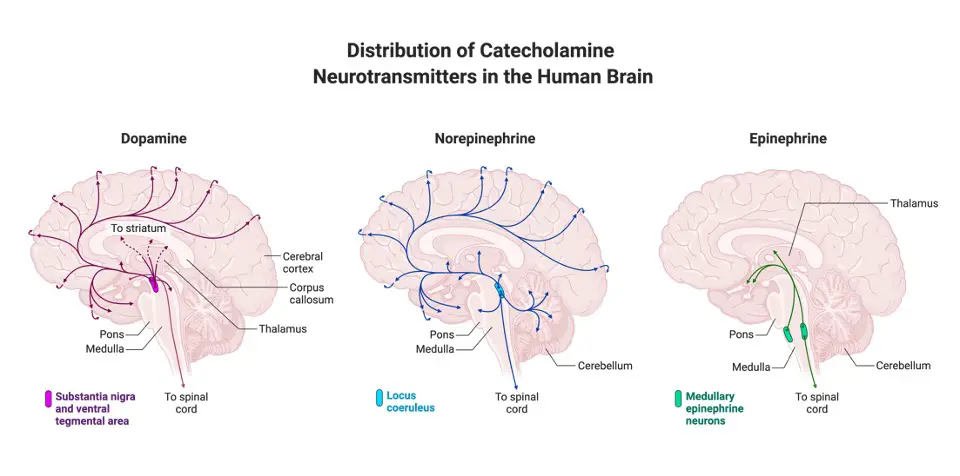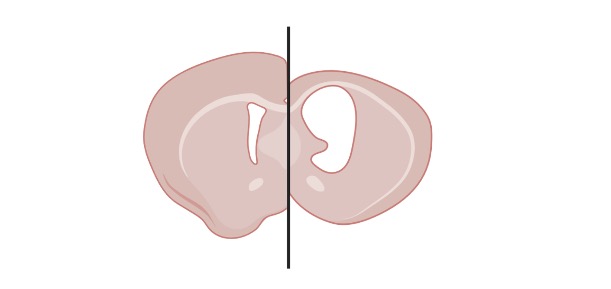Table of Contents
Dopamine Definition
3,4-dihydroxyphenethylamine (C8H11NO2) is a neurotransmitter or hormone (153 D) that is produced by decarboxylation of dihydroxyphenylalanine. This is an adrenaline and noradrenaline precursor.
What is Dopamine?
Dopamine is a naturally occurring chemical with a wide range of biological functions. Dopamine is an abbreviation for 3,4-dihydroxyphenylamine. Catecholamines and phenethylamines are their biochemical cousins. It’s an amine made by removing the carboxyl group from L-DOPA. Dopamine’s primary precursor is L-DOPA.
Biosynthesis of Dopamine
Dopamine is biosynthesized from L-DOPA using the enzyme DOPA decarboxylase and the cofactor pyridoxal phosphate in a main route. L-DOPA is made from L-Tyrosine in this route (L-Tyrosine, in turn, from L-Pheynlalanine).

Other small sources of dopamine exist in the human brain. L-Phenylalanine is transformed to L-Tyrosine, which is then turned to p-Tyramine in one minor route. The conversion of p-Tyramine to dopamine is catalysed by the enzyme cytochrome P450 2D6 in the brain.
L-Phenylalanine is transformed to m-Tyrosine, which is then converted to m-Tyramine, and eventually to dopamine, through a secondary route. Because dietary dopamine cannot pass the blood-brain barrier, it must come from major and minor metabolic pathways in order to be used in specific brain processes.
Dopamine Function
Plants and animals generate dopamine naturally. Dopamine is produced in a variety of tissues in humans. However, it is largely produced by neurons in the brain and cells in the medulla of the kidney’s adrenal glands.

It functions as a neurotransmitter and a neuromodulator in the brain. Neurons make and release it as a chemical signal to other neurons. One of its roles is to inspire people to perform things for a reward. Dopamine is often regarded as a pleasure (feel-good) molecule.
Dopamine levels rise as a result of anticipating a reward, which boosts motivation. This is one among the fundamental physiological elements in the reward system’s establishment and reinforcement of addictive behaviour.
Addictive drugs can increase dopamine release or block dopamine reuptake. Dopamine in the brain is involved in motor control, arousal, and executive processes in addition to motivation, reinforcement, and reward.
Dopamine Distribution and Function
Dopamine-producing neurons’ cell bodies are grouped together. They are, however, concentrated in tiny regions of the brain (substantia nigra, ventral tegmental region, posterior hypothalamus, arcuate nucleus, pericentricular nucleus, zona incerta, and so forth).

Despite this, their axons extend into various regions of the brain. The arcuate nucleus and periventricular nucleus of the hypothalamus, for example, have projections to the pituitary gland. The anterior pituitary receives dopamine from the arcuate nucleus of the hypothalamus, which is released from the axon terminal into the hypophyseal portal system of the median eminence.
Dopamine inhibits the production of prolactin by lactrotrophs in the anterior pituitary. As a result, dopamine is classified as a hypothalamus hormone and is also known as prolactin-inhibiting hormone (or as prolactostatin).
Another example is dopamine, which is produced from the zona incerta and travels via the hypothalamus to specific regions. Dopamine is implicated in the control of gonadotropin-releasing hormone in this regard. It functions as a chemical messenger outside of the brain. It prevents the release of norepinephrine into the circulation. It also has a vasodilator effect.
Dopamine is produced in different organs, and it has effects locally or on adjacent cells. It increases salt excretion in the kidneys, which results in higher urine production.
It decreases gastrointestinal motility in the digestive tract. It also reduces the amount of insulin produced by the pancreas. It also has an effect on the immune system by lowering lymphocyte activity.
Dopamine is generated and released by neuronal cells in the retina, in the eyes. Amacrine cells are those that lack axons. Cone cell activity is enhanced while rod cell activity is suppressed by retinal dopamine, allowing for greater sensitivity to colour and contrast in poor light circumstances.
Dopamine also serves as a precursor to norepinephrine, which is an essential role. The enzyme dopamine beta-hydroxylase, as well as the cofactors O2 and L-ascorbic acid, are involved in the conversion.
Dopamine is a precursor of norepinephrine and is used as a pharmaceutical medication. It stimulates dopaminergic, alpha, and beta-1 adrenergic receptors as well. It’s used pharmacologically to treat hypotension caused by bradycardia, as well as to increase cardiac and urine output.
Higher pulmonary pressure, worsening pulmonary congestion, increased myocardial work without improved coronary blood flow, aggravated myocardial ischemia, increased heart rate, and supraventricular or ventricular arrhythmias are all possible side effects.
2-(3,4-Dihydroxyphenyl) ethylamine, 3-Hydroxytramine, oxytyramine, prolactin suppressing factor, prolactin inhibiting hormone, and intropin are all synonyms for dopamine.
Nucleotide Citations
- Mechanisms and regulation of dopamine release. Curr Opin Neurobiol . 2019 Aug;57:46-53.
- Dopamine: Functions, Signaling, and Association with Neurological Diseases. Cell Mol Neurobiol . 2019 Jan;39(1):31-59.
- What does dopamine mean? Nat Neurosci . 2018 Jun;21(6):787-793.
- Figures are created with BioRender.com







